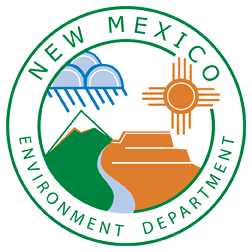Wildfires can produce significant water quality changes that may impact fish and other aquatic organisms, drinking water supplies and wastewater treatment systems. These impacts are cumulative as a result of pollutants mobilized by the fire, chemicals used to fight the fire, and the post-fire response of the landscape. Responses include both immediate / short-term responses as well as longer term (decade or more) impacts.
One of the first and greatest impacts of wildfire is a significant increase in watershed runoff which can lead to considerable downstream flooding. Runoff is magnified due to the loss of vegetation and the development of hydrophobic soils during intense wildfires. Rain that falls in a wildfire-impacted watershed cannot easily infiltrate into the ground because (1) the loss of vegetation and duff does not slow precipitation down once it hits the landscape, and (2) hydrophobic soils that may develop during a wildfire physically repels water. Increases in streamflow following a fire can result in little to substantial effects on the physical, chemical, and biological quality of the water in streams, rivers, and lakes. Concentrated runoff may combine with soil, rock fragments, sediment, ash, and woody debris to form debris flows that can be physically destructive and seriously degrade aquatic habitat. The magnitude of these effects is largely dependent on the size, intensity, and severity of the fire, on steepness of slopes, and on the condition of the watershed (e.g., healthy or degraded riparian areas) at the time of burning.
As mentioned previously, wildfires can affect the physical, chemical, and biological quality of streams, rivers, and lakes. After a fire, increased runoff provides the pathway for the transport of chemical-laden sediment to surface water, which may have substantial water quality impacts. The primary water quality concerns after a wildfire are:
1. The introduction of debris and sediment, including black ash, from burned vegetation. In the immediate period after the fire this runoff can result in fish kills by robbing the streams of oxygen through decomposition and by physically injuring the gills of fish. It can be detrimental to other aquatic life by smothering habitat upon which these organisms depend. Furthermore, increased sediment loading can drastically impact lake and reservoir holding capacities as well as the functionality of the outlet works by filling the system with sediment and debris.
2. The increase of nitrate and other plant nutrients. Burning vegetation releases nutrients contained within plants including nitrate, ammonia and phosphate. At high concentrations ammonia can be toxic to fish and other aquatic life. Elevated nutrient concentrations, especially nitrate, can be a concern if downstream uses include a public drinking water supply. Increases in nitrogen and phosphorous concentrations also may lead to algal blooms resulting in extreme daily fluctuations in oxygen or oxygen depletion as plant photosynthesis, respiration, and decomposition intensify. Anaerobic conditions (i.e., lack of oxygen) stress aquatic organisms and can alter a wide range of chemical equilibria, which may mobilize certain toxic pollutants.
3. The introduction of radionuclides and heavy metals from ash, soils, and geologic sources within the burned area. Gross alpha activity increases in stormwater runoff are strongly correlated with the amount of suspended sediment carried in stormwater. Post-fire flash floods contain extremely high levels of suspended sediment and subsequently have very high levels of gross alpha activity. Following the Cerro Grande Fire in 2000 the concentrations of several metals (e.g., copper, aluminum, barium, manganese, and zinc) increased and in some cases exceeded state water quality criteria. As the forest and soils recovered, these concentrations decreased and by 2010 these waters no longer exceeded state water quality criteria.
4. The introduction of fire retardant chemicals into waterbodies that can reach levels toxic to aquatic organisms. Fire retardants typically contain large amounts of nitrogen as ammonia, and they can cause water quality problems when fire-suppressing drops are made close to streams.
The magnitude of the effects of fire on water quality is primarily driven by fire severity (how much of the fuel is consumed) and fire intensity (how hot the fire burned) coupled with subsequent seasonal weather events (e.g., monsoon rainfall). In other words, the more severe the fire, the greater the amount of fuel consumed, the more nutrients released, and the more susceptible the watershed is to erosion of soil and The magnitude of the effects of fire on water quality is primarily driven by fire severity (how much of the fuel is consumed) and fire intensity (how hot the fire burned) coupled with subsequent seasonal weather events (e.g., monsoon rainfall). In other words, the more severe the fire, the greater the amount of fuel consumed, the more nutrients released, and the more susceptible the watershed is to erosion of soil and nutrients into the stream, which could negatively impact water quality. In addition, fire intensity affects the formation of hydrophobic soils that repel water and increase the probability of stormwater runoff in the watershed. Another important determinant of the magnitude of the effects of fire on water quality is the slope of the burned area; steeper slopes are more likely to result in greater runoff and transport of chemicals and sediment to streams, rivers, or lakes in the watershed.
For more information, please email the SWQB Watershed Protection Section Manager at wpsprogram.manager@env.nm.gov, or call (505) 827-0187.
Additional Resources:
– SWQB Mapper
– SWQB Frequently Asked Questions
– Post-Wildfire Debris Removal and Disposal FAQ
– New Mexico Fire Information
– New Mexico Fire Viewer
– InciWeb – Incident Information System
– SWQB Post-Wildfire Response Resources
– After Wildfire: A Guide for New Mexico Communities
– New Mexico Smoke Management and Air Quality
– Forest Service Alerts and Notices (including Fire Restrictions)
– 2024 Presentation on Wildfires and Water Quality

